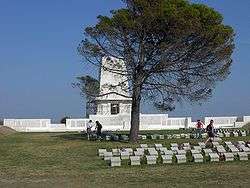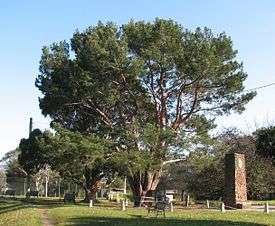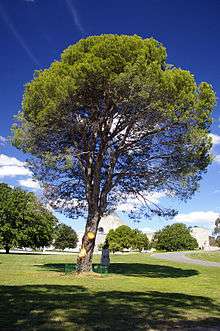Lone Pine (tree)
The Lone Pine was a solitary tree on the Gallipoli Peninsula in Turkey, which marked the site of the Battle of Lone Pine in 1915. It was a "Turkish Pine" of species Pinus brutia.

Pines which are planted as a memorial to the Australian and New Zealand soldiers who fought in Gallipoli are also known as "Lone Pines" or "Gallipoli Pines". However, there are at least two species of pine in that locality—in addition to "Turkish Pine" Pinus brutia, the "Aleppo Pine" Pinus halepensis is also common. Branches from "Allepo" pines were also used by the Turks to protect their trenches, and cones and seeds from "Allepo" pines are common at "Lone Pine" memorials in Australia, in particular, the tree at the Australian War Memorial.
The tree at the Lone Pine Cemetery at Gallipoli is of a third species—Stone pine Pinus pinea.
The original "Lone Pine"
The "original" Lone Pine, a "Turkish Pine" of species Pinus brutia, was the sole survivor of a group of trees that had been cut down by Turkish soldiers who had used the timber and branches to cover their trenches during the battle.[1] They had also cut down other trees to do this, most particularly "Aleppo Pines" Pinus halepensis. The tree was obliterated during the battle; however, pine cones that had remained attached to the cut branches over the trenches were retrieved by various Australian soldiers and brought home to Australia.[2][3] The resultant seedlings sent home by one soldier were found to be Turkish pines, but those sent home by a pair of soldiers were found to be Pinus halepensis (Aleppo pine). Initially, Turkish pines were regarded as a subspecies of Pinus halepensis (Aleppo pine), but now they are usually classified as a distinct species, Pinus brutia.[4]
Tree at Lone Pine Cemetery, Gallipoli
At the Lone Pine Cemetery on the Gallipoli peninsula, a solitary pine was planted in the 1920s to symbolise the original Lone Pine. This tree was inspected in 1987 by an Australian botanist and confirmed to be a stone pine (Pinus pinea).[1]
Trees in Australia


Pinus halepensis
Keith McDowell, an Australian soldier of the 23rd Battalion who fought at Gallipoli, brought a pine cone from the battle site home to Australia.[5] Many years later seeds from the cone were planted by his wife's aunt Emma Gray of Grassmere, near Warrnambool, Victoria and five seedlings emerged, with four surviving. These seedlings were planted in four different locations in Victoria: Wattle Park, Melbourne (8 May 1933), the Shrine of Remembrance (11 June 1933), the Soldiers Memorial Hall at The Sisters near Terang (18 June 1933) and Warrnambool Botanic Gardens (23 January 1934).[2]
The tree at the Shrine Reserve was planted near the north-east corner of the building by Lieutenant-General Sir Stanley Savige, founder of Melbourne Legacy, at a formal ceremony.[6] In 2005 the tree required cable bracing following the loss of a major limb and in August 2012, despite measures taken to try to save the tree from the effects of disease caused by the fungus Diplodia pinea, it was removed.[7][8] A "grandchild tree" was planted nearby in 2006.[8] A Middle Park man, Andrew Lees, collected cones from the broken limb in 2005 and by 2015 had managed to germinate about 20 seedlings.[9]
Another soldier, Lance Corporal Benjamin Smith from the 3rd Battalion, also retrieved a cone from the battle site and sent it back to his mother in Australia, (Mrs McMullen), who had lost another son at the battle. Seeds from the cone were planted by her in 1928, from which two seedlings were raised.[3] One was presented to her home town of Inverell, New South Wales and the other was forwarded to Canberra where it was planted by Prince Henry, Duke of Gloucester at the Australian War Memorial (AWM) in October 1934.[3] The AWM lone pine lost two of its large lower limbs by strong winds preceding a thunderstorm on 27 December 2008. However, tree surgeons were able to save the historic tree.[10][11]
Both Melbourne Legacy and the Yarralumla Nursery in Canberra have raised and grown seedlings over a number of years, sourced from the tree at the Shrine of Remembrance and the Australian War Memorial respectively, which they have presented to schools as well as ex-service and other organisations throughout Australia.[12]
Other "Lone Pines" include:
- Plaques at the base of the pine tree at the Oatley Park Avenue entrance to Oatley Park, NSW, state it was planted in 1920 by Owen Jones Davies from pine cones obtained from Lone Pine, Gallipoli.
- The two Lone Pine seedlings at the Australian Defence Force Academy in Canberra were presented by the RSL on Remembrance Day, 11 November 1987.
- The pine at the Battle of Lone Pine memorial at Adelaide's National War Memorial is accompanied by a plaque stating "This pine is a seedling related to the original Lone Pine on Gallipoli"
- A seedling of Pinus brutia, propagated from the original tree at Lone Pine was planted in the grounds of the Victorian School of Forestry at Creswick on 23 March 1975.[13] A plaque was also unveiled by Legacy.
- Two Lone Pine seedlings at ADFA (Canberra) - Pinus halepensis
- Coolah, NSW -
Pinus halepensis - Cootamundra, NSW -
Pinus halepensis - Lowther, NSW -
Pinus halepensis - Mundubbera, Qld -
Pinus halepensis
"Lone Pines" with accompanying plaques:
 Adelaide's memorial -
Adelaide's memorial -
Pinus halepensis
 Australian War Memorial
Australian War Memorial
Pinus halepensis
- Balranald, NSW -
Pinus halepensis - Crookwell, NSW -
Pinus halepensis - Finley, NSW
- Manangatang, Vic -
Pinus halepensis
Trees in New Zealand
In Auckland, two trees identified as "Lone Pines" have been planted. One is a Pinus canariensis planted at Waikumete cemetery in 1961 and another is a Pinus radiata at Auckland War Memorial Museum, planted by Victoria Cross recipient Cyril Bassett on Anzac Day in 1950.[12] A tree identified as "The Anzac Pine" stands on Te Mata Peak at Havelock North in Hawkes Bay. Although a specimen of Pinus brutia was originally planted, the current tree is identified as the species Pinus radiata.[12] Two specimens of Pinus halepensis, planted in 1951, are located at the Lone Pine Memorial at the cemetery in Taradale, and further specimens are located at King Edward Park in Stratford and Queens Park in Wanganui.[12] There is a "Lone Pine" at the Paeroa golf course, at the ladies tee, on the second hole. This tree appears to be New Zealand's only authentic Pinus brutia that can be traced back to the original pines, according to "Excerpts from NZ Journal of Forestry, May 2007". Also, in Victoria Park, Christchurch, there is a plaque which claims that the nearby pine tree was grown from a seedling of the Gallipoli Lone Pine.
References
- "Champion Trees in Commonwealth War Cemeteries" (PDF). Commonwealth War Graves Commission. Archived from the original on 21 July 2011. Retrieved 29 March 2012.CS1 maint: unfit url (link)
- "Gallipoli "Lone Pine" lives on" (PDF). Legacy. Retrieved 29 March 2012.
- "The Lone Pine Tree". Australian War Memorial. Retrieved 29 March 2012.
- Spencer, R.D. (1995) Horticultural Flora of South-eastern Australia 1: 248-249 (University of NSW Press).
- "The Shrine Reserve". Shrine of Remembrance Education Program: Background Information (PDF). Shrine of Remembrance. pp. 8–10. Retrieved 29 March 2012.
- "Lone Pine – Shrine Reserve". City of Melbourne. Archived from the original on 16 September 2006. Retrieved 29 March 2012.CS1 maint: unfit url (link)
- Smethurst, Annika (24 August 2012). "Melbourne's Lone Pine tree, planted with seeds from Gallipoli Peninsula, has been cut down". Herald Sun. News Corp Australia. Retrieved 28 September 2012.
- Smith, Bridie (22 June 2012). "Shrine's Lone Pine facing battle to death with attacking fungus". The Age. Retrieved 1 July 2012.
- "No need to pine for a chip off the old block". The Weekly Review Bayside. 9 February 2015. Archived from the original on 2 April 2015.
- Dodd, Mark (2008-12-29). "Living war memorial at risk". News Limited. The Australian. Archived from the original on 2008-12-31. Retrieved 2009-01-11.
- Lane, Sabra (2008-12-30). "Australian War Memorial's Lone Pine will survive". Australian Broadcasting Corporation. AM. Retrieved 2009-01-11.
- Wilcox, Mike; Spencer David (2007). "Stand up for the real Anzac Lone Pine of Gallipoli" (PDF). New Zealand Journal of Forestry. 52 (1): 3–9. Retrieved 11 February 2017.
- "Pinus brutia (lone pine). ," Creswick Campus Historical Collection".
- "Te Mata and Ruapuke honour rolls | NZHistory, New Zealand history online". nzhistory.govt.nz. Retrieved 2019-10-09.
| Wikimedia Commons has media related to Lone Pine (tree). |
.jpg)